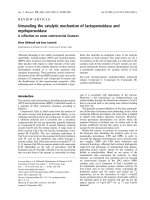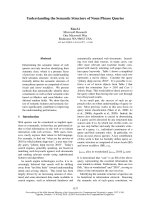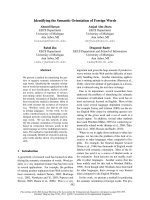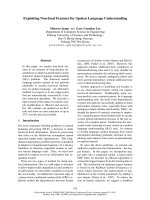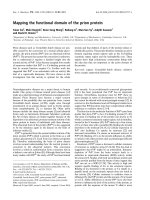Báo cáo khoa học: "Discovering the Lexical Features of a Language" pot
Bạn đang xem bản rút gọn của tài liệu. Xem và tải ngay bản đầy đủ của tài liệu tại đây (181.76 KB, 2 trang )
Discovering the Lexical Features of a Language
Eric Brill *
Department of Computer and Information Science
University of Pennsylvania
Philadelphia, PA 19104
emaih
1 Introduction
This paper examines the possibility of automatically
discovering the lexieal features of a language. There
is strong evidence that the set of possible lexical fea-
tures which can be used in a language is unbounded,
and thus not innate. Lakoff [Lakoff 87] describes
a language in which the feature
-I-woman-or-fire-or-
dangerons-thing
exists. This feature is based upon
ancient folklore of the society in which it is used. If
the set of possible lexieal features is indeed unbounded,
then it cannot be part of the innate Universal Gram-
mar and must be learned. Even if the set is not un-
bounded, the child is still left with the challenging task
of determining which features are used in her language.
If a child does not know a priori what lexical fea-
tures are used in her language, there are two sources
for acquiring this information: semantic and syntactic
cues. A learner using semantic cues could recognize
that words often refer to objects, actions, and proper-
ties, and from this deduce the lexical features: noun,
verb and adjective. Pinker [Pinker 89] proposes that
a combination of semantic cues and innate semantic
primitives could account for the acquisition of verb fea-
tures. He believes that the child can discover semantic
properties of a verb by noticing the types of actions
typically taking place when the verb is uttered. Once
these properties are known, says Pinker, they can be
used to reliably predict the distributional behavior of
the verb. However, Gleitman [Gleitman 90] presents
evidence that semantic cues axe not sufficient for a
child to acquire verb features and believes that the
use of this semantic information in conjunction with
information about the subcategorization properties of
the verb may be sufficient for learning verb features.
This paper takes Gleitman's suggestion to the ex-
treme, in hope of determining whether syntactic cues
may not just aid in feature discovery, but may be all
that is necessary. We present evidence for the suffi-
ciency of a strictly syntax-based model for discovering
*The author would like to thank Mitch Marcus for valuable
help. This work was supported by AFOSR jointly under grant
No. AFOSR-90-0066, and by ARO grant No. DAAL 03-89-
C0031 PRI.
the lexical features of a language. The work is based
upon the hypothesis that whenever two words are se-
mantically dissimilar, this difference will manifest it-
self in the syntax via
playing out the notion
51]). Most, if not all,
For instance, there is
lexical distribution (in a sense,
of distributional analysis [Harris
features have a semantic basis.
a clear semantic difference be-
tween most count and mass nouns. But while meaning
specifies the core of a word class, it does not specify
precisely what can and cannot be a member of a class.
For instance,
furniture
is a mass noun in English, but
is a count noun in French. While the meaning of
fur-
niture
cannot be sufficient for determining whether it
is a count or mass noun, the distribution of the word
Call.
Described below is a fully implemented program
which takes a corpus of text as input and outputs a
fairly accurate word class list for the language in ques-
tion. Each word class corresponds to a lexical feature.
The program runs in O(n 3) time and
O(n 2)
space,
where n is the number of words in the lexicon.
2 Discovering Lexical Features
The program is based upon a Markov model. A
Markov model is defined as:
1. A set of
states
2. Initial state probabilities init(x)
3. Transition probabilities trans(x,~)
An important property of Markov models is that they
have no memory other than that stored in the current
state. In other words, where X(t) is the value given by
the model at time t,
P,(X(t) = ~, I x(t - 1) = ~,_, x(o) = ~o) =
Pr(X(t) = ~tt [ X(t
1) = at-l)
In the model we use, there is a unique state for each
word in the lexicon. We are not concerned with initial
state probabilities. Transition probabilities represent
the probability that word b will follow a and are esti-
mated by examining a large corpus of text. To estimate
the transition probability from state a to state
b:
339
1. Count the number of times b follows a in the corpus.
2. Divide this value by the number of times a occurs in
the corpus.
Such a model is clearly insufficient for expressing
the grammar of a natural language. However, there
is a great deal of information encoded in such a model
about the distributional behavior of words with respect
to a very local context, namely the context of imme-
diately adjacent words. For a particular word, this
information is captured in the set of transitions and
transition probabilities going into and out of the state
representing the word in the Markov model.
Once the transition probabilities of the model have
been estimated, it is possible to discover word classes.
If two states are sufficiently similar with respect to the
transitions into and out of them, then it is assumed
that the states are equivalent. The set of all suffi-
ciently similar states forms a word class. By varying
the level considered to be sufficiently similar, different
levels of word classes can be discovered. For instance,
when only highly similar states are considered equiva-
lent, one might expect animate nouns to form a class.
When the similarity requirement is relaxed, this class
may expand into the class of all nouns. Once word
classes are found, lexical features can be extracted by
assuming that there is a feature of the language which
accounts for each word class. Below is an example ac-
tually generated by the program:
With very strict state similarity requirements, HE and
SHE form a class. As the similarity requirement is re-
laxed, the class grows to include I, forming the class
of singular nominative pronouns. Upon further relax-
ation, THEY and WE form a class. Next, (HE, SHE,
I) and (THEY, WE) collapse into a single class, the
class of nominative pronouns. YOU and IT collapse
into the class of pronouns which are both nominative
and accusative. Note that next, YOU and IT merge
with the class of nominative pronouns. This is because
the program currently deals with bimodals by eventu-
ally assigning them to the class whose characteristics
they exhibit most strongly. For another example of
this, see HER below.
3 Results and Future Direc-
tions
This algorithm was run on a Markov model trained
on the Brown Corpus, a corpus of approximately one
million words [Francis 82]. The results, although pre-
liminary, are very encouraging. These are a few of the
word classes found by the program:
• CAME WENT
• THEM ME HIM US
• HER HIS
• FOR ON BY IN WITH FROM AT
• THEIR MY OUR YOUR ITS
• ANY MANY EACH SOME
• MAY WILL COULD MIGHT WOULD CAN
SHOULD MUST
• FIRST LAST
• LITTLE MUCH
• MEN PEOPLE MAN
This work is still in progress, and a number of dif-
ferent directions are being pursued. We are currently
attempting to automatically acquire the suffixes of a
language, and then trying to class words based upon
how they distribute with respect to suffixes.
One problem with this work is that it is difficult to
judge results. One can eye the results and see that
the lexical features found seem to be correct, but how
can we judge that the features are indeed the correct
ones? How can one set of hypothesized features mean-
ingfully be compared to another set? We are currently
working on an information-theoretic metric, similar to
that proposed by Jelinek [Jelinek 90] for scoring prob-
abilistic context-free grammars, to score the quality of
hypothesized lexical feature sets.
References
[Francis 82] Francis, W. and H. Kucera. (1982)
Frequency Anal-
ysis
o.f
English Usage: Le~c.icon and Grammar.
Houghton Mifflin Co.
[G|eitman 90] G|eitman, Lila. (1990) "The Structural Sources
of
Verb Meanings."
Language Acquisition,
Voltmae
1, pp. 3-55.
[Harris 51] Harris, Zeli 8.
(1951)
Structural Lingulstics.
Chicago: University
of
Chicago Press.
[Jelinek 90] Jellnek, F., J.D. Lafferty & R.L. Mercer. (1990)
"Basic Methods of Probahilistic Context Free
Grvannmrs."
I.B.M. Technical Report,
RC 16374.
[Lakoff87] Lakoff, G. (1987)
Women, Fire and Dangerous
Things: What Categories Reveal About the Mind.
Chicago: University of Chicago Press.
[Pinker 89] Pinker, S.
Learnability and Cognition.
Cambridge:
MIT Press.
340




